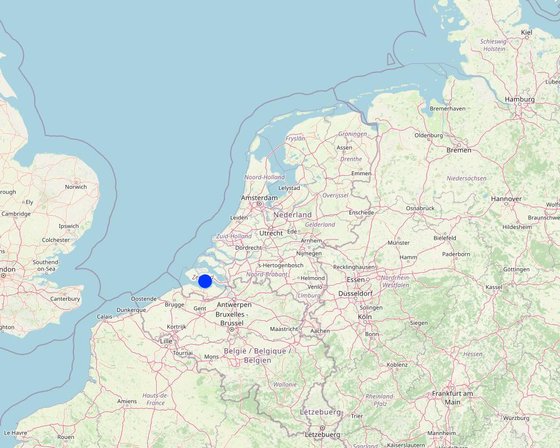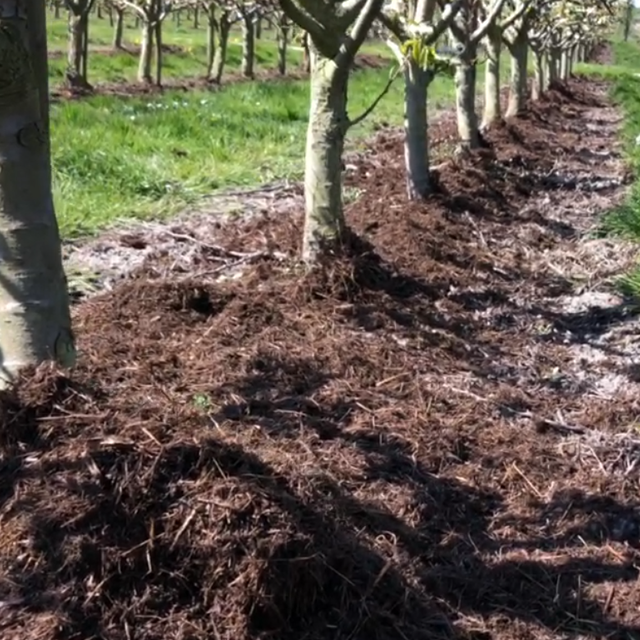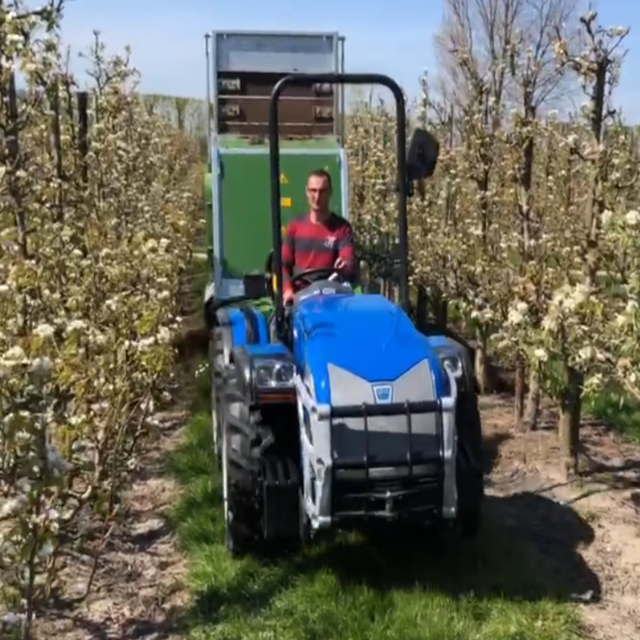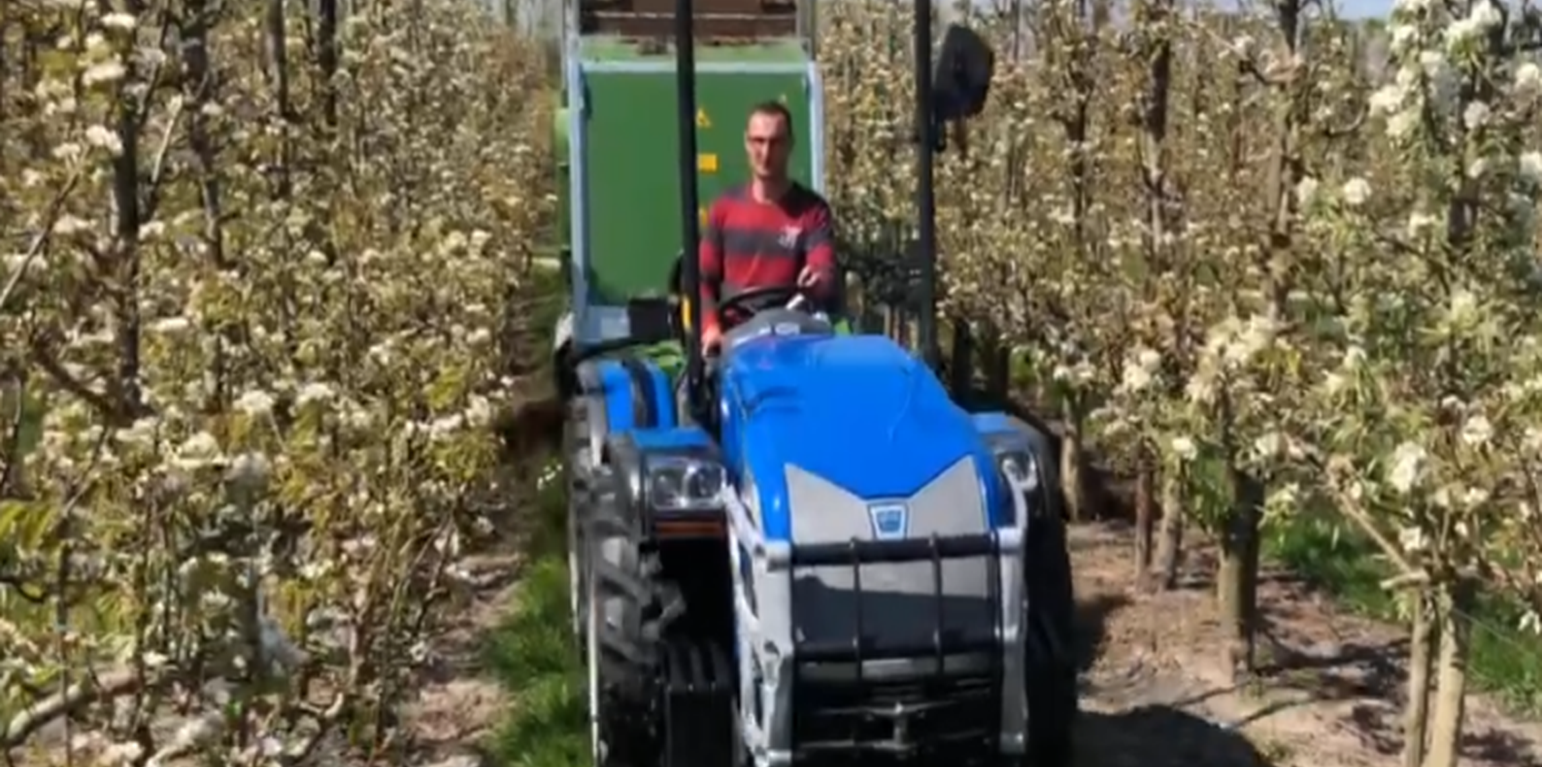Soil improvement in orchards through use of bokashi (fermented clippings)
(Netherlands)
Bodemverbetering in fruitteelt met behulp van bokashi
Description
Bokashi is a soil amendment formed by fermenting clippings of vegetation. It helps to increase soil organic matter content in fruit orchards.
Bokashi is a soil amendment formed from fermentation of vegetative clippings. It has a high organic matter content. Furthermore, due to the fermentation process, bokashi is practically free of weed seeds. The high organic matter content feeds soil organisms and results in the increase of soil organic matter, and in turn this supports the growth of micro-organisms, improves water holding capacity and increases soil fertility. Bokashi is applied once a year underneath the fruit trees in autumn after the harvest by a mechanical spreader. Here 16 tonnes of bokashi was applied on 1ha. Results have shown that fruit trees grow better in the resulting healthier soil, but spreading the bokashi is labour intensive. This technology has been applied on a parcel of land in Zeeland in the south of the Netherlands.
Location

Location: Kamperland, Zeeland, Netherlands
No. of Technology sites analysed: single site
Geo-reference of selected sites
Spread of the Technology: evenly spread over an area (approx. < 0.1 km2 (10 ha))
In a permanently protected area?: Nee
Date of implementation: 2020
Type of introduction
-
through land users' innovation
-
as part of a traditional system (> 50 years)
-
during experiments/ research
-
through projects/ external interventions

Spreading of the bokashi underneath the fruit trees (Wico Dieleman)

Spreading of the bokashi (Wico Dieleman)
Classification of the Technology
Main purpose
-
improve production
-
reduce, prevent, restore land degradation
-
conserve ecosystem
-
protect a watershed/ downstream areas – in combination with other Technologies
-
preserve/ improve biodiversity
-
reduce risk of disasters
-
adapt to climate change/ extremes and its impacts
-
mitigate climate change and its impacts
-
create beneficial economic impact
-
create beneficial social impact
Land use
Land use mixed within the same land unit: Nee
-
Forest/ woodlandsTree types (deciduous): n.a.
Products and services: Fruits and nuts
Water supply
-
rainfed
-
mixed rainfed-irrigated
-
full irrigation
Purpose related to land degradation
-
prevent land degradation
-
reduce land degradation
-
restore/ rehabilitate severely degraded land
-
adapt to land degradation
-
not applicable
Degradation addressed
-
chemical soil deterioration - Cn: fertility decline and reduced organic matter content (not caused by erosion)
SLM group
-
improved ground/ vegetation cover
-
integrated soil fertility management
-
integrated pest and disease management (incl. organic agriculture)
SLM measures
-
agronomic measures - A2: Organic matter/ soil fertility
Technical drawing
Technical specifications
Establishment and maintenance: activities, inputs and costs
Calculation of inputs and costs
- Costs are calculated: per Technology area (size and area unit: 1ha; conversion factor to one hectare: 1 ha = 1ha = 2.47 acres)
- Currency used for cost calculation: EUR
- Exchange rate (to USD): 1 USD = 0.95 EUR
- Average wage cost of hired labour per day: 250
Most important factors affecting the costs
Access to suitable machinery to reduce the labour costs.
Establishment activities
-
Spreading compost (Timing/ frequency: August)
-
Cultivating the land (Timing/ frequency: August)
-
Sowing catch crop (Timing/ frequency: August)
Establishment inputs and costs (per 1ha)
| Specify input |
Unit |
Quantity |
Costs per Unit (EUR) |
Total costs per input (EUR) |
% of costs borne by land users |
|
Labour
|
| Labour |
ha |
6.0 |
35.0 |
210.0 |
100.0 |
|
Equipment
|
| Machinery |
ha |
1.0 |
50.0 |
50.0 |
100.0 |
|
Fertilizers and biocides
|
| Bokashi purchase |
ha |
25.0 |
12.5 |
312.5 |
100.0 |
| Total costs for establishment of the Technology |
572.5 |
|
| Total costs for establishment of the Technology in USD |
602.63 |
|
Maintenance activities
n.a.
Natural environment
Average annual rainfall
-
< 250 mm
-
251-500 mm
-
501-750 mm
-
751-1,000 mm
-
1,001-1,500 mm
-
1,501-2,000 mm
-
2,001-3,000 mm
-
3,001-4,000 mm
-
> 4,000 mm
Agro-climatic zone
-
humid
-
sub-humid
-
semi-arid
-
arid
Specifications on climate
Average annual rainfall in mm: 800.0
Slope
-
flat (0-2%)
-
gentle (3-5%)
-
moderate (6-10%)
-
rolling (11-15%)
-
hilly (16-30%)
-
steep (31-60%)
-
very steep (>60%)
Landforms
-
plateau/plains
-
ridges
-
mountain slopes
-
hill slopes
-
footslopes
-
valley floors
Altitude
-
0-100 m a.s.l.
-
101-500 m a.s.l.
-
501-1,000 m a.s.l.
-
1,001-1,500 m a.s.l.
-
1,501-2,000 m a.s.l.
-
2,001-2,500 m a.s.l.
-
2,501-3,000 m a.s.l.
-
3,001-4,000 m a.s.l.
-
> 4,000 m a.s.l.
Technology is applied in
-
convex situations
-
concave situations
-
not relevant
Soil depth
-
very shallow (0-20 cm)
-
shallow (21-50 cm)
-
moderately deep (51-80 cm)
-
deep (81-120 cm)
-
very deep (> 120 cm)
Soil texture (topsoil)
-
coarse/ light (sandy)
-
medium (loamy, silty)
-
fine/ heavy (clay)
Soil texture (> 20 cm below surface)
-
coarse/ light (sandy)
-
medium (loamy, silty)
-
fine/ heavy (clay)
Topsoil organic matter content
-
high (>3%)
-
medium (1-3%)
-
low (<1%)
Groundwater table
-
on surface
-
< 5 m
-
5-50 m
-
> 50 m
Availability of surface water
-
excess
-
good
-
medium
-
poor/ none
Water quality (untreated)
-
good drinking water
-
poor drinking water (treatment required)
-
for agricultural use only (irrigation)
-
unusable
Water quality refers to: both ground and surface water
Is salinity a problem?
Occurrence of flooding
Characteristics of land users applying the Technology
Market orientation
-
subsistence (self-supply)
-
mixed (subsistence/ commercial)
-
commercial/ market
Off-farm income
-
less than 10% of all income
-
10-50% of all income
-
> 50% of all income
Relative level of wealth
-
very poor
-
poor
-
average
-
rich
-
very rich
Level of mechanization
-
manual work
-
animal traction
-
mechanized/ motorized
Sedentary or nomadic
-
Sedentary
-
Semi-nomadic
-
Nomadic
Individuals or groups
-
individual/ household
-
groups/ community
-
cooperative
-
employee (company, government)
Age
-
children
-
youth
-
middle-aged
-
elderly
Area used per household
-
< 0.5 ha
-
0.5-1 ha
-
1-2 ha
-
2-5 ha
-
5-15 ha
-
15-50 ha
-
50-100 ha
-
100-500 ha
-
500-1,000 ha
-
1,000-10,000 ha
-
> 10,000 ha
Scale
-
small-scale
-
medium-scale
-
large-scale
Land ownership
-
state
-
company
-
communal/ village
-
group
-
individual, not titled
-
individual, titled
Land use rights
-
open access (unorganized)
-
communal (organized)
-
leased
-
individual
-
Partnership
Water use rights
-
open access (unorganized)
-
communal (organized)
-
leased
-
individual
Access to services and infrastructure
employment (e.g. off-farm)
drinking water and sanitation
Impacts
Socio-economic impacts
Crop production
Mulch effect improved crop growth
Ecological impacts
soil moisture
Mulch keeps better soil moisture
soil loss
More material reduced soil loss
nutrient cycling/ recharge
Mulch provides more organic matter for nutrient cycling activity
soil organic matter/ below ground C
Mulch provides soil organic matter to soil profile
Cost-benefit analysis
Benefits compared with establishment costs
Short-term returns
very negative
very positive
Long-term returns
very negative
very positive
Benefits compared with maintenance costs
Short-term returns
very negative
very positive
Long-term returns
very negative
very positive
Climate change
Gradual climate change
seasonal rainfall decrease
not well at all
very well
Adoption and adaptation
Percentage of land users in the area who have adopted the Technology
-
single cases/ experimental
-
1-10%
-
11-50%
-
> 50%
Of all those who have adopted the Technology, how many have done so without receiving material incentives?
-
0-10%
-
11-50%
-
51-90%
-
91-100%
Has the Technology been modified recently to adapt to changing conditions?
To which changing conditions?
-
climatic change/ extremes
-
changing markets
-
labour availability (e.g. due to migration)
Conclusions and lessons learnt
Strengths: land user's view
-
Soil moisture retention improvements
-
Soil organic matter improvements
-
Soil life increased significantly after applying bokashi to the soil. There was no eutrophication
Strengths: compiler’s or other key resource person’s view
-
Reduced weed burden in compost with fermentation
Weaknesses/ disadvantages/ risks: land user's viewhow to overcome
-
Time intensive to spread compost
NA
-
Limited availability of bokashi currently
Knowledge exchange to support more uptake of bokashi production
Weaknesses/ disadvantages/ risks: compiler’s or other key resource person’s viewhow to overcome
References
Reviewer
-
Rima Mekdaschi Studer
-
William Critchley
Date of documentation: Julie 6, 2023
Last update: Okt. 3, 2023
Resource persons
-
Tijmen Hoogendijk - SLM specialist
-
Richard Rijk - land user
-
Wico Dieleman - SLM specialist
Full description in the WOCAT database
Documentation was faciliated by
Institution
- Zuidelijke Land en Tuinbouw Organisatie (ZLTO) - Netherlands
Project
- European Interreg project FABulous Farmers









